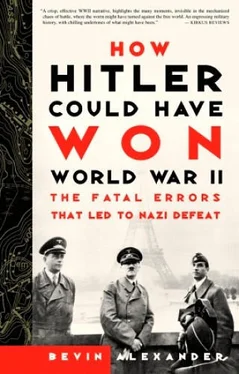Fearing the tanks, Rommel paused briefly to work out an attack. It was a fatal delay. It gave the British armor just enough time to get behind Alamein and form a defensive force. Rommel had had just one chance to break through at Alamein. If he had struck at once, he could have rushed on to Alexandria and the Delta. He did not. This was the moment Rommel lost the war in Africa.
Rommel attacked the next day, Wednesday, July 1, 1942. His reputation was so awesome that the news terrified the British. The fleet withdrew through Suez into the Red Sea. In Cairo, headquarters hastily burned files. Commanders frantically planned to evacuate Cairo and the Delta.
Africa Corps’s assault went in about twelve miles south of the sea at Deir el Shein and hit a box Rommel didn’t know was there. Defended by the 18th Indian Brigade, the box held till evening, when the Germans smashed it and captured most of the defenders. British armor arrived too late to save the brigade, but in time to check Rommel’s efforts during the night to penetrate to the rear.
From this point on, Axis presence in Africa was doomed. Rommel renewed the attack the next day, but he had fewer than forty tanks now and was forced to halt when he saw British tanks blocking their way, as well as others moving around their flank. Rommel tried again on July 3. By now he had only twenty-six tanks, yet he advanced nine miles before British fire halted them. During the day a New Zealand battalion captured nearly all of Ariete Division’s artillery in a flank attack, while the remaining Italians took to their heels. It was clear evidence of exhaustion and overstrain.
Rommel, at last recognizing reality, broke off the attack. Auchinleck had at last gained the initiative. He counterattacked on July 4. The Axis troops held, and both sides soon stopped out of exhaustion. Now the two opponents slowly built their strength. In the following weeks they exchanged savage attempts to crack the other’s line. The tactical situation altered little. But the strategic situation had been transformed. The Axis had no hope of matching the huge buildup that had begun apace on the British side.
Churchill flew out to Cairo on August 4 and changed commanders when he found Auchinleck strongly resisting his insistence on renewing the offensive. Auchinleck wanted to wait until September so newly arrived troops could learn desert warfare. Churchill handed over the Middle East command to General Sir Harold Alexander and brought out General Sir Bernard Montgomery from England to run the 8th Army. Montgomery turned out to be more insistent than any officer in the army in meticulously tidying up his forces before doing anything. He took even longer than Auchinleck, but Churchill couldn’t admit he’d been wrong, and gave way.
Rommel launched one more desperate offensive on August 30. It had to go in on a less-fortified stretch to the south, but 8th Army had mined the region, and German mobility was limited by shortage of fuel. Rommel at last had to pull back, defeated. From this point on, the Axis forces simply hung on, waiting for the British blow to fall.
14 STALINGRAD

THE STALINGRAD CAMPAIGN IN RUSSIA IN 1942 IS ONE OF THE MOST POIGNANT examples ever recorded of a ruler engineering his own destruction.
When the army chief of staff, Franz Halder, protested the self-defeating operations, Hitler removed him. Only in the late stages when the German 6th Army had been isolated and a quarter of a million men were about to be lost was Erich von Manstein able to induce Hitler to grant just enough leeway to keep the entire southern wing of the German army from being destroyed as well.
After Stalingrad, Germany surrendered the initiative in Russia. Hitler never could summon enough strength thereafter to alter the balance of power against him. Despite heroic efforts by his soldiers, he had doomed himself to the slow, inevitable destruction of his army and his regime.
Two elements of the 1942 campaign stand out. First, Hitler committed the oldest and most obvious mistake in warfare: he neglected the principle of concentration and split his efforts between capturing Stalingrad on the Volga River and seizing the oil fields of the Caucasus. Either task would have been enough for his gravely weakened army. It was madness to attempt both, since the two thrusts diverged in different directions over hundreds of miles, leaving insufficient strength in either arena. The Red Army seized the opportunity, stopped both offensives, and concentrated against the closest danger, Stalingrad.
This brought on the second element of the campaign: Hitler, instead of being satisfied with an advance to the Volga and interdicting traffic on the river, which had been his stated aim, insisted on 6th Army capturing the city itself. This forced it to concentrate in the built-up area at the end of an extremely deep salient, offering the Russians an invitation to lock 6th Army in place by launching a street-by-street urban battle. As this titanic hand-to-hand clash went on, the Soviets assembled armies on the long, weakly held defensive lines on either flank, unleashed a powerful counteroffensive, and surrounded 6th Army.
Russian preparations for this counteroffensive were unmistakable. Yet Hitler refused to allow 6th Army to withdraw, and—because he had committed his other forces to the Caucasus—had insufficient troops to strengthen either flank of the salient.
Well before the Russians actually launched their counterstrike on November 19, 1942, the battle for the city had been lost. After 6th Army was encircled, Hitler refused to marshal strength from less-threatened theaters to break through the Russian ring and free the trapped army. The forces made available to Manstein, who was saddled with the job, were too few and arrived too late.
In the end, Manstein could not save 6th Army, and had to expend his skill and troops to keep an even greater Stalingrad from being created by a thrust of the Red Army to Rostov, where it could cut off Manstein’s army group and the army group in the Caucasus.
At every stage Hitler made disastrous decisions—dividing his army in the first place, insisting on seizure of Stalingrad, refusing to allow 6th Army to retreat, failing to go all out to save the army once it had been surrounded, and refusing to heed evidence that the Russians were about to isolate the two army groups in the far south.
By 1943 the incapacity of Adolf Hitler as a commander was revealed for all to see. This showed Red Army generals not only that he could be beaten, but how he could be beaten. And it proved to senior German officers that, since Hitler would not listen to them, there was little chance of a stalemate, and the Allies would almost surely insist on total subjugation of Germany.
The German army in the east ( Ostheer ) came out of the winter of 1941–1942 with 2.4 million men on the front, counting replacements, more than 600,000 fewer than had started the campaign in June 1941. The situation was worst among infantrymen, whose numbers had fallen 50 percent in the south and 65 percent in the center and north. This weaker army had to defend a line that, since Hitler prohibited straightening out loops and protuberances, wove in and out for 2,800 miles from the Baltic to the Black Sea.
The quantity of German weapons was declining as well. Tank production was below 600 units a month. When Halder told Hitler Soviet tank manufacture was more than three times as great, Hitler slammed the table and said it was impossible. “He would not believe what he did not want to believe,” Halder wrote in his diary.
At least the Mark IV tanks had been rearmed with long-barreled high-velocity 75-millimeter guns and could meet the Soviet T-34s on better terms. But nearly a third of the artillery pieces were old French cannons, the number of combat-ready aircraft had fallen to half what it had been in June 1941, while shortages of fuel and ammunition were great and growing.
Читать дальше



![Джонатан Димблби - Barbarossa - How Hitler Lost the War [calibre]](/books/385421/dzhonatan-dimblbi-barbarossa-how-hitler-lost-the-w-thumb.webp)









